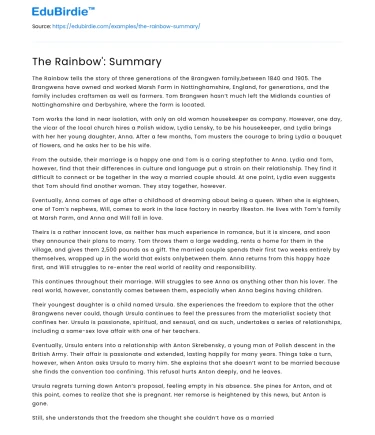The Rainbow tells the story of three generations of the Brangwen family,between 1840 and 1905. The Brangwens have owned and worked Marsh Farm in Nottinghamshire, England, for generations, and the family includes craftsmen as well as farmers. Tom Brangwen hasn’t much left the Midlands counties of Nottinghamshire and Derbyshire, where the farm is located.
Tom works the land in near isolation, with only an old woman housekeeper as company. However, one day, the vicar of the local church hires a Polish widow, Lydia Lensky, to be his housekeeper, and Lydia brings with her her young daughter, Anna. After a few months, Tom musters the courage to bring Lydia a bouquet of flowers, and he asks her to be his wife.
Save your time!
We can take care of your essay
- Proper editing and formatting
- Free revision, title page, and bibliography
- Flexible prices and money-back guarantee
From the outside, their marriage is a happy one and Tom is a caring stepfather to Anna. Lydia and Tom, however, find that their differences in culture and language put a strain on their relationship. They find it difficult to connect or be together in the way a married couple should. At one point, Lydia even suggests that Tom should find another woman. They stay together, however.
Eventually, Anna comes of age after a childhood of dreaming about being a queen. When she is eighteen, one of Tom’s nephews, Will, comes to work in the lace factory in nearby Ilkeston. He lives with Tom’s family at Marsh Farm, and Anna and Will fall in love.
Theirs is a rather innocent love, as neither has much experience in romance, but it is sincere, and soon they announce their plans to marry. Tom throws them a large wedding, rents a home for them in the village, and gives them 2,500 pounds as a gift. The married couple spends their first two weeks entirely by themselves, wrapped up in the world that exists onlybetween them. Anna returns from this happy haze first, and Will struggles to re-enter the real world of reality and responsibility.
This continues throughout their marriage. Will struggles to see Anna as anything other than his lover. The real world, however, constantly comes between them, especially when Anna begins having children.
Their youngest daughter is a child named Ursula. She experiences the freedom to explore that the other Brangwens never could, though Ursula continues to feel the pressures from the materialist society that confines her. Ursula is passionate, spiritual, and sensual, and as such, undertakes a series of relationships, including a same-sex love affair with one of her teachers.
Eventually, Ursula enters into a relationship with Anton Skrebensky, a young man of Polish descent in the British Army. Their affair is passionate and extended, lasting happily for many years. Things take a turn, however, when Anton asks Ursula to marry him. She explains that she doesn’t want to be married because she finds the convention too confining. This refusal hurts Anton deeply, and he leaves.
Ursula regrets turning down Anton’s proposal, feeling empty in his absence. She pines for Anton, and at this point, comes to realize that she is pregnant. Her remorse is heightened by this news, but Anton is gone.
Still, she understands that the freedom she thought she couldn’t have as a married woman can now only be achieved if she agrees to marry Anton. At this point, she observes a rainbow in the sky, and takes it to be a sign of a new reality for humanity. The book describes it this way: 'She saw in the rainbow the earth's new architecture, the old, brittle corruption of houses and factories swept away, the world built up in a living fabric of Truth, fitting to the over-arching heaven.'Afterward, Ursula sits to write a letter to Anton, asking him to return.
The Rainbow addresses the competing interests of modernity and tradition. The characters across the generations each struggle under the weight of expectations as they feel pulled toward a different sort of life than the one they are leading. In particular, Lawrence critiques the institution of marriage. The relationships he depicts in the novel are all deeply flawed, marriages that exists primarily as a result of function or convenience. The book argues that people should abandon these conventions in favor of following their urges and more animal instincts.
The Rainbow frankly, and at times explicitly, discusses human sexuality and sexual attraction, and that earned the novel an obscenity trial in England in 1915. Unsold copies of the book were seized and burned, though it remained available in the United States.
Critics have praised the novel’s artistry, and have gone on to remark favorably on the book’s depiction of sexual attraction. Most critics also agree that Lawrence’s treatment of convention in the face of modernity is noteworthy.
Lawrence wrote a sequel to The Rainbow, Women in Love, with Ursula as the main character. In that book, she continues her search for emotional and spiritual growth through other relationships.






 Stuck on your essay?
Stuck on your essay?

